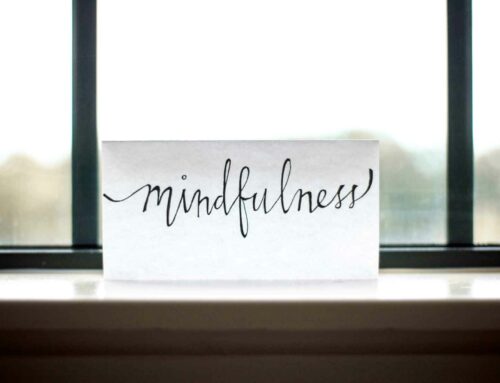Mindfulness is the foundational skill of dialectical behavior therapy (DBT). Mindfulness is an intentional meditation that helps you to feel more calm, re-engage your prefrontal cortex, live in the present moment, and make decisions that bring peace to your life. If your daughter is struggling with anxiety, self harm, anger, or other behavioral health issues, learn how applying DBT mindfulness skills can help her. Incorporating mindfulness and meditation into your everyday life will improve stress levels and overall mental health.
What is mindfulness?
How do you practice mindfulness?
What is wise mind?
The benefits of mindfulness.
What is Mindfulness
Mindfulness is helpful to reduce stress, lessen anxiety, and live in the present. Mindfulness is the foundational skill of DBT and essential to help your daughter move into a state of wise mind. As it calms her mind and body, she’ll feel an increase in peace and gratitude.
THE FOUNDATIONAL DBT SKILL
DBT helps your daughter to regulate her emotions, build and maintain positive relationships, learn to self-soothe in times of crisis, and see both sides of an argument. However, none of these skills would be fully effective without a foundation of mindfulness. Mindfulness increases awareness of your external surroundings and your internal state of being. This awareness will guide the decisions your daughter makes and the other DBT skills she will choose to use.
Sunrise RTC is a fully-integrated DBT treatment center that teaches teen girls to live the principles of DBT, not just learn them. Your daughter’s individual and family therapist will use mindfulness-based therapy, along with the other DBT skills, to help her reduce anxiety and improve her ability to process through struggles.
How to practice mindfulness
WHAT you do
- Observe your senses and surroundings
- Describe by putting your observations into words
- Participate fully in the present moment
HOW you do it
- Don’t judge yourself or your surroundings, simply notice
- Stay focused as best you can, and gently redirect your thoughts when they start to wander
- Do what works best for you to practice mindfulness
SPIRITUAL, BUT NOT RELIGIOUS
Many people worry that mindfulness is a religious meditation practice. Mindfulness is not associated with any particular religion, but can be a spiritual process for those who want it to be. Mindfulness has origins in Eastern religions such as Hinduism, Buddhism, and Taoism. However, the act of mindfulness — intentional awareness of the present moment without judgment — is not religious. Mindfulness is spiritual in the sense that it can help your daughter connect to her inner self and find or create peace.
INCREASED AWARENESS + PRESENT MOMENT = INCREASED GRATITUDE
When your daughter is feeling overwhelmed by daily life stressors and lengthy to-do lists, it’s harder to notice the small things she’s grateful for. Practicing mindfulness will bring an increased awareness of the present moment, and she’ll find that she feels an increase in gratitude. She might notice how nice a cool breeze feels on a warm day, or that a friend picked up the book she dropped at school. When she has a mindful awareness of her environment and approaches it with an attitude of kindness, she’ll find more to be grateful for.

MEDITATION AND RELAXATION
Mindfulness is inherently meditative and calming. During a mindfulness exercise, your daughter will concentrate on her breath and any sensations in her body (such as feeling “butterflies” in her belly or a tightness in her throat and chest). As she slows down her breath, she will also slow down physiologically and reduce anxiety or ruminating thoughts. Your daughter can practice mindfulness meditation on her own, or with coaching as she learns the skills. Mindfulness-based stress reduction is a practice that can help in almost any situation where she feels overwhelmed.
How do you practice mindfulness?
There are two guiding skills to use as you coach your daughter or yourself in mindfulness practices: the “what” skills and the “how” skills.
WHAT SKILLS
The “what” skills teach you how to enter a state of mindfulness.
Observe
The first step to begin practicing mindfulness is to observe your surroundings using your senses. What do you touch, see, hear, taste, smell? If you were at a family holiday party, you might observe that you feel the thick carpet beneath your feet and that the couch you’re sitting on is leather (touch). As you look around, you might notice the color of the walls and that your son is using his phone (sight). You might hear the timer beep in the kitchen and your nephew crying in the next room (sound). As you focus on what you smell, you notice the scent of pine wood burning in the fire and soup simmering on the stove. You taste remnants of the drink in your hand. You can also do a body scan to observe what emotions or other sensations you might be experiencing. In this first stage, you’re simply observing without ascribing meaning or judgment to your observations.
Describe
Next, you’ll describe by putting your observations into words. (If you’re in a social situation, you can say this silently to yourself.) As you do so, state only the facts — no need to add your judgment (“That drink was great”) or your interpretation (“My nephew is crying, so I should help my sister”). You might state, “I notice that a timer is going off in the kitchen” or “I notice that I’m feeling a tingly sensation in my gut”.
To describe something without adding any judgment takes a lot of practice. Encourage patience for yourself and your daughter as you work through this step.
Participate
The last step in the “what” skills is to be in the present and participate fully in the moment, provided that the situation is safe. If your daughter is anxious at this family function, you can encourage her to participate in the moment by playing a game with her cousins, talking with her grandparents, or helping in the kitchen. As any teen might be resistant to this idea and prefer to distract with her phone, you can further encourage her by allowing her to choose the amount of time she wants to practice this skill. Even five minutes may be beneficial.
HOW SKILLS
The “how” skills teach you how to act once you are practicing mindfulness.
Don’t judge
While you’re practicing or coaching your daughter in mindfulness and meditation, try to approach yourself and the world around you with an attitude of kindness and openness. Let thoughts, sensations, and observations come and go without judgment. Simply notice them.
Stay focused
Do your best to keep your focus on the mindfulness practice. If you find that your attention has started to wander, gently guide it back. If it’s helpful, try setting a timer for five or ten minutes. Tell yourself that during that time, you will keep your attention on mindful awareness or your meditation practice.
Do what works
Finally, practice mindfulness in whatever way works best for you. There is no right or wrong way to be mindful. You might try practicing mindfulness lying down or while on a walk; alone indoors or outside in a busy park. As you practice, you might choose to pay attention to one of your body’s senses, all of your senses, or your breath only. Practice in different ways until you find a process that works best for you.
HOW DOES MINDFULNESS WORK?
As you practice the “what” and “how” skills of wise mind, you will find that you feel more calm, more aware, and more effective.
HOW DOES MINDFULNESS WORK? MINDFULNESS AT SUNRISE
At Sunrise, your daughter will learn that when she is experiencing heightened emotions, she is not going to be effective in her interactions or decisions. Through mindfulness-based therapy, she will learn that as she practices mindfulness and focuses on her breathing, she will re-engage her prefrontal cortex and feel more calm and rational. This allows her to gain a new perspective and help her to be more effective.
MINDFULNESS AT HOME
When you notice that your daughter’s emotions are beginning to escalate, you can coach her through a mindfulness activity to help her calm down. You might ask her to take five deep breaths and describe some things that she hears, sees, and smells. Repeat these steps until she’s able to process what she’s feeling.
As a parent, mindfulness can help you be more effective in your interactions with your children. If you’re anxious about a child who is struggling emotionally or behaviorally, it will be more difficult for you to make the best decision about how to treat her. Try using mindfulness-based stress reduction skills to help you in your daily life, as well as during challenging times as a parent.
What is wise mind?
Wise mind is your ideal state of mind, in which you make decisions from a good and peaceful place. In wise mind, you pay attention to both your head and your heart — your rational mind and your emotional mind.
EMOTION MIND + RATIONAL MIND = WISE MIND
As humans, we get information about what we want from two places: our rational minds or our emotional hearts (called your “emotional mind” in DBT). Both give us excellent information about a situation, such as what feels right, what feels wrong, what makes sense, and your personal feelings. When you only listen to one source of information, you’ll likely make a decision that isn’t the best one for you.

Some people find themselves perpetually stuck in a state of rational mind, or in a state of emotional mind. Others alternate between the two. When you’re able to be in tune with both mindsets at the same time, you enter a state of wise mind. In wise mind, you carefully consider both logic and emotions before reacting to a situation or making a final decision.
WISE MIND AND DECISION MAKING
Both your reasonable mind and your emotional mind provide you with valuable information; but alone, neither is necessarily correct. For example, your emotional mind will tell you how you feel about the situation and how you want to react in that moment. But to make the best decision, you also need input from your logic and reason. When the two work together, you’re able to find a solution that makes sense and will feel right to you in the long term. Wise mind helps you take the best information from each side to make your decision. This brings you peace in your everyday life as you acknowledge both sides and make your decision based on the information available to you.
WISE MIND AT SUNRISE
We had a student at Sunrise who struggled with emotions and went into active passivity. She wouldn’t get anything resolved, and then she’d go to invalidation by calling herself stupid and saying that she couldn’t get anything right. She avoided making decisions, and when she did, they were usually impulsive and caused more regret in the future.
The student’s family therapist decided to use a mindfulness-based intervention with her. She began her mindfulness practice by observing what she was experiencing, and then describing what it felt like physiologically. Then, she would do five to ten minutes of mindfulness meditation. With staff coaching, she would do deep breathing and relaxation. Once she was more calm, she could use reasonable mind to identify her emotions and check the facts with staff help. She was then in wise mind and could find effective ways to solve the problem she was facing.
Eventually, she was able to start doing this on her own, still needing coaching here and there. She became more skilled in her interactions and more effective in the way she addressed problems. As a result, she started feeling more competent and better about herself and her overall mental health improved.

WISE MIND AT HOME
As a parent, wise mind can help you make better decisions — especially when you’re feeling frustrated with a child. Before responding to a difficult situation, take some time to notice what both your reasonable mind and your emotional mind are telling you to do. Use that information to make a decision you’ll feel good about later.
Wise mind can help your daughter at home, whether in everyday circumstances, or when making a big decision. If your daughter is contemplating where to go to college, she will want to consider both her reason and her emotion to create a decision in wise mind. In emotional mind, she’ll ask questions such as, “How far is campus from home? Do I like the campus? Will I fit in with the other students?” In reasonable mind, she’ll consider, “How much is tuition? Do they offer the field of study I’m most interested in? What will I use for transportation?” Both sets of questions are equally important in choosing where to attend college. Using her wise mind to thoroughly consider both sides will guide her towards a choice that will help her have a fulfilling and enjoyable college experience.
MINDFULNESS EXERCISE PRACTICE SKILLS
Use this free mindfulness practice worksheet to help you and your daughter practice mindfulness and wise mind.
The benefits of mindfulness and wise mind.
Mindfulness can benefit you and your daughter in many different ways. As the most basic skill of dialectical behavior therapy, it will increase your ability to fully engage in and reap the benefits of other DBT skills. It also engages the frontal lobe and increases feelings of peace and calm. Mindfulness exercises allow you to be more in tune with yourself and your surroundings.
Wise mind is a guide to making the best decision possible by using information from both our emotions and our logic. As we engage our whole self in decision making, we will find answers that bring us peace.
Get help for your daughter at a DBT treatment center.
If you’re interested in learning more about how mindfulness and DBT can help your daughter recover from her behavioral health issues, contact us now to discuss if a fully-integrated DBT treatment center is the best fit for your family.




